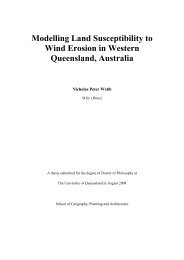Final Report: Strengthening Community Research in ... - Ninti One
Final Report: Strengthening Community Research in ... - Ninti One
Final Report: Strengthening Community Research in ... - Ninti One
Create successful ePaper yourself
Turn your PDF publications into a flip-book with our unique Google optimized e-Paper software.
4.4 <strong>Research</strong> project on vehicle safety: <strong>Research</strong> Cycle 1.2<strong>Research</strong> Team: Judy Lovell, Ada Lechleitner, Mark Inkamala, Anna Marie Armstrong, Roslyn Raberabera, RachelKantawara, Dion DhamarranydjiRoslyn Raberabera and Anna MarieArmstrong (right)Mark Inkamala (left) runs focus groupwith Tjuwanpa RangersBackyard photograph for focus group4.4.1 Data collectionThis research cycle made use of two data collection methods – photo elicitation and focus groups – that workedtogether to provide a rich qualitative response to the guid<strong>in</strong>g research questions. The researchers asked smallgroups of people to discuss photos <strong>in</strong> light of the f<strong>in</strong>d<strong>in</strong>gs of the Safe Driv<strong>in</strong>g Survey (above, and Lovell et al. 2011).The researchers facilitated the discussion to cover key po<strong>in</strong>ts. The benefit of the method was the flow ofconversation that represented layers of <strong>in</strong>formation from participants. The researchers guided the conversationsby br<strong>in</strong>g<strong>in</strong>g the group back to the focus on the topic us<strong>in</strong>g the photos or the key questions as needed. The methodrecords detail, allow<strong>in</strong>g the depth of the th<strong>in</strong>k<strong>in</strong>g and differences of op<strong>in</strong>ion <strong>in</strong> each group to be captured as audiorecorded data. This is called a focus group.In order to start the focus group with everyone look<strong>in</strong>g closely at the same everyday scenes, the researchers tookphotographs around the community that illustrated the focus of the discussion. The photos were used with eachgroup, accompanied by the questions: ‘What do you see <strong>in</strong> these photos?’ and ‘What’s go<strong>in</strong>g on here?’ This is calledthe photo elicitation method (Kolb 2008), and can be used <strong>in</strong> focus groups, with other clusters of <strong>in</strong>formants orwith <strong>in</strong>dividuals.The vehicle safety focus groups were run dur<strong>in</strong>g August and September 2011 <strong>in</strong> response to the Safe driv<strong>in</strong>gsurvey from May 2011, which questioned local people about their driv<strong>in</strong>g habits and concerns. From analysis ofthe surveys some f<strong>in</strong>d<strong>in</strong>gs were identified as subjects for further enquiry. The f<strong>in</strong>d<strong>in</strong>gs <strong>in</strong>dicated important po<strong>in</strong>ts:1. People will drive, if they have no other options.2. People want to drive safe vehicles.3. People want driver education and tra<strong>in</strong><strong>in</strong>g at Ntaria.We learned that 45% of people surveyed suggested:1. Driv<strong>in</strong>g education and tra<strong>in</strong><strong>in</strong>g is needed at Ntaria.2. Safe driv<strong>in</strong>g, driver fatigue, dr<strong>in</strong>k driv<strong>in</strong>g and license renewal programs are needed at Ntaria.3. Young drivers need more tra<strong>in</strong><strong>in</strong>g and skill development opportunities at Ntaria.42 <strong>F<strong>in</strong>al</strong> <strong>Report</strong>: <strong>Strengthen<strong>in</strong>g</strong> <strong>Community</strong> <strong>Research</strong> <strong>in</strong> Remote Service Delivery at Ntaria
















